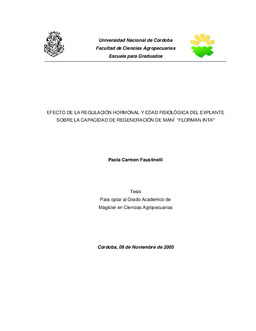| dc.contributor.advisor | Racca, Roberto W. | |
| dc.contributor.author | Faustinelli, Paola Carmen | |
| dc.date.accessioned | 2015-03-18T13:55:43Z | |
| dc.date.available | 2015-03-18T13:55:43Z | |
| dc.date.issued | 2005 | |
| dc.identifier.uri | http://hdl.handle.net/11086/1758 | |
| dc.description | Tesis (Magister en Ciencias Agropecuarias)--UNC- Facultad de Ciencias Agropecuarias, 2005. | es |
| dc.description.abstract | El maní (Arachis hypogaea L.) es uno de los principales cultivos de leguminosas y es globalmente valorado por su contenido de proteínas y la calidad de su aceite. El principal objetivo de esta investigación fue determinar la concentración de auxinas y citocininas óptima para cada una de las cuatro etapas del proceso de regeneración organogenético de maní var. Florman INTA. Las concentraciones de auxinas y citocininas que resultaron óptimas para cada una de las etapas fueron las siguientes: (i) Establecimiento: El medio de -1 -1 Murashige y Skoog (MS) suplementado con 1 mg l de ANA y 3 mg l de BA optimizó la producción de yemas y brotes a partir de gémulas del embrión con un tamaño entre 3 a 5 mm, obtenidas de semillas de 3 a 5 días de pre-germinadas; (ii) Elongación: Medio MS -1 suplementado con 0.01 mg l de ANA y en ausencia de BA promovió una eficiente elongación de los brotes, con una mínima formación de callos; (iii) Enraizamiento: Medio -1 MS con la adición de 3 mg l de ANA optimizó la formación de raíces clasificadas morfológicamente del tipo “engrosadas” y (iv) Rusticación: el sistema radicular obtenido en -1 el medio suplementado con 3 mg l de ANA permitió una alta supervivencia de las plántulas al transplante. La eficiencia general del sistema resultó ser de un 15%. Las plantas transplantadas a suelo fueron totalmente normales y capaces de producir semillas. El segundo objetivo de esta tesis fue evaluar, a partir de gémulas extraídas de semillas pre-germinadas, la relación entre la edad fisiológica de las semillas y su capacidad para formar yemas adventicias. La edad fisiológica de la semilla donante del explante se evaluó en base a su deterioro bajo dos condiciones de almacenamiento: ambiente (22.5°C promedio) y heladera (4°C). Mensualmente y durante un año, se determinó la capacidad -1 regenerativa de estos explantes cultivándolos en un medio suplementado con 1 mg l NAA -1 y 3 mg l BA. No pudimos corroborar la existencia de una relación entre la edad fisiológica de la semilla donante del explante, evaluada a través de su deterioro, y la capacidad de ese explante de regenerar brotes. Las semillas conservadas en heladera por un período de doce meses, mantuvieron sus cualidades endógenas más constantes otorgándole al explante donado mayor integridad a nivel de membranas y tejidos. | es |
| dc.description.abstract | Peanut (Arachis hypogaea L.) is one of the most important leguminous crops. It is a
rich source of proteins and oil. Tissue culture has been used for genetic modification of
peanut to improve the agronomical and nutritional attributes of this crop. The main
objective of this research was to determine the optimum concentration of auxins and
cytokinins in the basal media needed during the organogenesis process of the peanut var.
Florman INTA. The first two leaves (2-5 mm in length) removed from aseptically
germinated seeds were cultivated on Murashige and Skoog (MS) medium supplemented
with 16 combinations of naphthaleneacetic acid (NAA) (0.01 and 1 mg l -1 ) and
benzyladenine (BA) or Kinetin (KIN) (1 to 10 mg l -1 ) during the Initiation stage. Bud
regeneration occurred in all hormone combinations, but the maximum number of buds was
regenerated at a concentration of 1 mg l -1 NAA with 3 mg l -1 BA. Development of buds into
shoots was readily achieved by transferring regenerated buds into fresh medium containing
0.01 mg l -1 NAA (without BA). Broadened roots were induced to grow when shoots were
transferred to medium with 3 mg l -1 of NAA added. This root system allowed for a high
survival rate of the plantlets after transplanting. The overall efficiency of the system was of
15%. Plants transplanted into soil were completely normal and capable of producing seeds.
Our secondary objective was to assess the relationship of physiological age of seeds
and the formation of adventitious buds. The physiological age of the explants donor seed
was assessed based on its rate of deterioration at two storage temperatures: 22.5oC and 4oC.
Every month during one year, we tested the regeneration capacity of these explants
culturing them in 1 mg l -1 NAA with 3 mg l -1 BA media. We could not find any correlation
between seed age and the regeneration capacity of the seeds. However, seeds refrigerated
during twelve month, maintained most of their endogenous qualities and gave the donor
explants more wholeness at the membrane and tissue level compared to those donated from
seeds kept at room temperature. | en |
| dc.format.extent | 67 h. : ilustración color | |
| dc.language.iso | spa | es |
| dc.rights | Atribución-NoComercial-SinDerivadas 2.5 Argentina | * |
| dc.rights.uri | http://creativecommons.org/licenses/by-nc-nd/2.5/ar/ | * |
| dc.subject | Control hormonal | es |
| dc.subject | Explantes | es |
| dc.subject | Cultivo in vitro | es |
| dc.subject | Regeneración | es |
| dc.subject | Organogénesis | es |
| dc.subject | Arachis hypogaea | es |
| dc.subject | Maní | es |
| dc.title | Efecto de la regulación hormonal y edad fisiológica del explante sobre la capacidad de regeneración de maní "Florman INTA" | es |
| dc.type | masterThesis | es |





